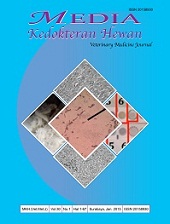Risk Factors for Patellar Luxation in Dogs in the Philippines
Downloads
A retrospective case-control study was conducted on dogs with patellar luxation who presented to the Veterinary Teaching Hospital Diliman Station-Companion Animal Clinic between January 1, 2010, and December 31, 2019. There was a total of 73 dogs were diagnosed with patellar luxation. The majority of the dogs presented with limping, and the causes were mostly unknown. Unilateral medial patellar luxation was the most common type (21.92%). The average age of patients with patellar luxation was 3.24 years old. Puppies are 0.03 less likely to be diagnosed with patellar luxation, while juveniles are 3.74 times more likely, and mature adults are 2.19 times more likely to be diagnosed. The affected dogs included intact males (47.95%), neutered males (4.11%), and intact females (47.95%). The average weight of the affected dogs was 8.39 kg and the majority (35.62%) had a body condition score of 5/9. The Pomeranian was the most common breed for patellar luxation, followed by the mixed breed Shih Tzu, Toy Poodle, and Chihuahua. Mixed breeds are 0.39 times less likely, and dogs fed with dry dog food are 0.51 times less likely to develop the condition. Age and breed were also significantly associated with patellar luxation.
Abdollahzad H., M.A. Aghdashi, M.A. Jafarabadi, and B. Alipour. 2015. Effects of coenzyme Q10 supplementation on inflammatory cytokines (TNF-a, IL-6) and oxidative stress in rheumatoid arthritis patients: a randomized controlled trial. Archives of medical research 46(7), 527-33. doi: 10.1016/j.arcmed.2015.08.006.
Alam M.R., J.I. Lee, H.S. Kang, I.S. Kim, S.Y. Park, K.C. Lee, and N.S. Kim. 2007. Frequency and distribution of patellar luxation in dogs. Veterinary and comparative orthopaedics and traumatology, 20, 59-64. doi: 10.1055/s-0037-1616589.
Arthurs G.I. and S.J. Langley-Hobbs. 2007. Patellar luxation as a complication of surgical intervention for the management of cranial cruciate ligament rupture in dogs: A retrospective study of 32 cases. Veterinary and comparative orthopaedics and traumatology, 20, 204-210. doi: 10.1160/VCOT-06-10-0074.
DeCamp C.E., S.A. Johnston, L.M. Déjardin, and S.L. Schaefer. 2016. Brinker, piermattei, and flo's handbook of small animal orthopedics and fracture repair (5th ed.). St. Louis, MO: Elsevier.
Di Dona F., G. Della Valle, and G. Fatone. 2018. Patellar luxation in dogs. Veterinary medicine: research and reports, 9, 23-32. doi: 10.2147/VMRR.S142545
Fauron A. and K.L. Perry. 2016. Canine patellar luxation part 1: pathophysiology and diagnosis. Veterinary Times, 46, 20-22.
Fauron A. and K.L. Perry. 2016. Treatment and outcomes for canine patellar luxation part 2. Veterinary Times, 46, 20-23.
Fossum T.W. (2019). Small animal surgery (5th ed.). Philadelphia, PA: Elsevier.
Gibbons S.E., C. Macias, M.A. Tonzing, G.L. Pinchbeck, and W.M. McKee. 2006. Patellar luxation in 70 large breed dogs. Journal of small animal practice, 47, 3-9. doi: 10.1111/j.1748- 5827.2006.00004.x.
Gustafsson P.O., H. Kasstrom, and G. Ljunggren. 1969. Estradiol induced patellar luxation in the dog: an experimental study. Veterinary Radiology, 10(1), 49–54. doi:10.1111/j.1740- 8261.1969.tb00624.x.
Harvey N.D. 2021. How Old Is My Dog? Identification of Rational Age Groupings in Pet Dogs Based Upon Normative Age-Linked Processes. Frontiers in veterinary science, 8, 643085. doi.org: 10.3389/fvets.2021.643085.
Holloway A. and F. McConnell (Eds.). 2013. BSAVA manual of canine and feline radiography and radiology: a foundation manual. Gloucester: British Small Animal Veterinary Association.
Hutchinson T. and K. Robinson (Eds.). 2015. BSAVA manual of canine practice: a foundation manual. Gloucester: British Small Animal Veterinary Association.
Innes J.F., C.J. Fuller, E.R. Grover, A.L. Kelly, and J.F. Burn. 2003. Randomised, double-blind, placebo-controlled parallel group study of P54FP for the treatment of dogs with osteoarthritis. Veterinary Record, 152, 457-460. doi: 10.1136/vr.152.15.457.
Jerosch J. 2011. Effects of glucosamine and chondroitin sulfate on cartilage metabolism in OA: outlook on other nutrient partners especially omega-3 fatty acids. International Journal of Rheumatology 2011, 1-17. doi: 10.1155/2011/969012
Johnson J.A., C Austin, and G.J. Breur. 1994. Incidence of Canine Appendicular Musculoskeletal Disorders in 16 Veterinary Teaching Hospitals from 1980 through 1989. Veterinary and comparative orthopaedics and traumatology, 7, 56-69. doi:10.1055/s-0038-1633097.
Johnston S.A., R.M. McLaughlin, and S.C. Budsberg. 2008. Nonsurgical Management of osteoarthritis in dogs. Veterinary Clinics of North America: Small Animal Practice, 38, 1449–1470. doi:10.1016/j.cvsm.2008.08.001.
Kirberger R.M. and F.J. McEvoy (Eds.). 2016. BSAVA manual of canine and feline musculoskeletal imaging (2nd ed.). Gloucester: British Small Animal Veterinary Association.
Knowles R.P. 1967. Clinical experience with DMSO in small animal practice. Annals of the new york academy of sciences, 141(1), 478-83. doi: 10.1111/j.1749-6632.1967.tb34914.x.
Lavrijsen I.C.M., H.C.M. Heuven, G.J. Breur, P.A.J. Leegwater, F.J. Meutstege, and H.A.W. Hazewinkel. 2013. Phenotypic and genetic trends of patellar luxation in Dutch Flat-Coated Retrievers. Animal Genetics, 44(6), 736–741. doi:10.1111/age.12077.
Martini F.M., A.B. de Bellesini, A. Miolo, L. Del Coco, F.P. Fanizzi, and A Crovace. 2017. Combining a joint health supplement with tibial plateau leveling osteotomy in dogs with cranial cruciate ligament rupture. An exploratory controlled trial. International journal of veterinary science and medicine 5(2), 105-112. doi:10.1016/j.ijvsm.2017.09.006.
Nganvongpanit K. and T. Yano. 2011. Prevalence of and risk factors of patellar luxation in dogs in chiang mai, thailand, during the years 2006–2011. The thai journal of veterinary medicine, 41(4), 449-454.
O' Neill D.G., R.L. Meeson, A. Sheridan, D.B. Church, and D.C. Brodbelt. 2016. The epidemiology of patellar luxation in dogs attending primary-care veterinary practices in England. Canine genetics and epidemiology, 3(1). doi: 10.1186/s40575-016-0034-0.
Perez T.E., K.L. Mealey, T.L. Grubb, S.A. Greene, and M.H. Court. 2016. Tramadol metabolism to o- desmethyl tramadol (M1) and n-desmethyl tramadol (M2) by dog liver microsomes: species comparison and identification of responsible canine cytochrome P450s. Drug metabolism and disposition, 44(12): 1963–1972. doi: 10.1124/dmd.116.071902.
Plumb D.C. 2011. Plumb's veterinary drug handbook (7th ed.). Stockholm, WI: PharmaVet Inc.
Smith R.D. 2005. Veterinary clinical epidemiology (3rd ed.). Boca Raton, FL: CRC Press.
Soontornvipart K., C. Wangdee, M. Kalpravidh, A. Brahmasa, M. Sarikaputi, J. Temwichitr, I.C.M. Lavrijsen, L.F.H. Theyse, Leegwater PAJ, and Hazewinkel HAW. (2013). Incidence and genetic aspects of patellar luxation in Pomeranian dogs in Thailand. The Veterinary Journal, 196(1), 122–125. doi:10.1016/j.tvjl.2012.07.027.
Copyright (c) 2023 Rey Barcenas Oronan, Dr. Nacion, Dr. Calibo

This work is licensed under a Creative Commons Attribution-ShareAlike 4.0 International License.

Veterinary Medicine Journal by Unair is licensed under a Creative Commons Attribution-ShareAlike 4.0 International License.
1. The Journal allows the author to hold the copyright of the article without restrictions.
2. The Journal allows the author(s) to retain publishing rights without restrictions
3. The legal formal aspect of journal publication accessibility refers to Creative Commons Attribution Share-Alike (CC BY-SA).





11.jpg)







11.png)













